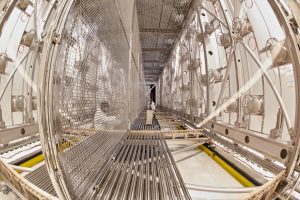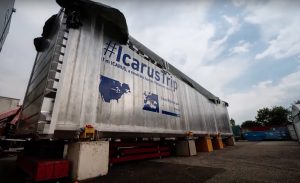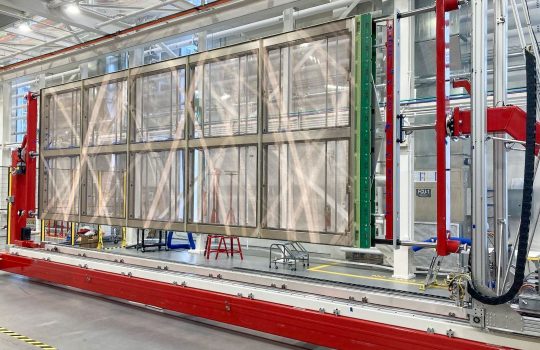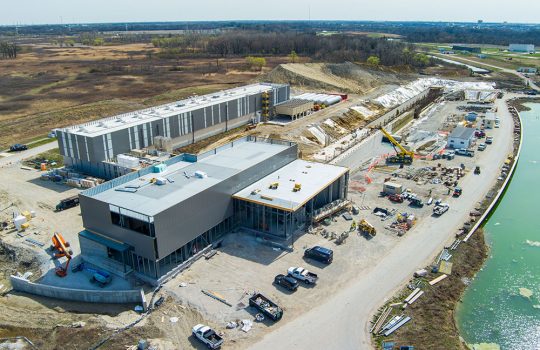The world’s largest particle hunter of its kind will travel across the ocean from CERN to Fermilab this summer to become an integral part of neutrino research in the United States.
It’s lived in two different countries, and it’s about to make its way to a third. It’s the largest machine of its kind, designed to find extremely elusive particles and tell us more about them. Its pioneering technology is the blueprint for some of the most advanced science experiments in the world. And this summer, it will travel across the Atlantic Ocean to its new home (and its new mission) at the U.S. Department of Energy’s Fermi National Accelerator Laboratory.

The ICARUS detector, seen here in a cleanroom at CERN, is being prepared for its voyage to Fermilab. Photo: CERN
It’s called ICARUS, and you can follow its journey over land and sea with the help of an interactive map on Fermilab’s website.
The ICARUS detector measures 18 meters (60 feet) long and weighs 120 tons. It began its scientific life under a mountain at the Italian National Institute for Nuclear Physics’ (INFN) Gran Sasso National Laboratory in 2010, recording data from a beam of particles called neutrinos sent by CERN, Europe’s premier particle physics laboratory. The detector was shipped to CERN in 2014, where it has been upgraded and refurbished in preparation for its overseas trek.
When it arrives at Fermilab, the massive machine will take its place as part of a suite of three detectors dedicated to searching for a new type of neutrino beyond the three that have been found. Discovering this so-called “sterile” neutrino, should it exist, would rewrite scientists’ picture of the universe and the particles that make it up.
“Nailing down the question of whether sterile neutrinos exist or not is an important scientific goal, and ICARUS will help us achieve that,” said Fermilab Director Nigel Lockyer. “But it’s also a significant step in Fermilab’s plan to host a truly international neutrino facility, with the help of our partners around the world.”
First, however, the detector has to get there. Next week it will begin its journey from CERN in Geneva, Switzerland, to a port in Antwerp, Belgium. From there the detector, separated into two identical pieces, will travel on a ship to Burns Harbor, Indiana, in the United States, and from there will be driven by truck to Fermilab, one piece at a time. The full trip is expected to take roughly six weeks.
An interactive map on Fermilab’s website (IcarusTrip.fnal.gov) will track the voyage of the ICARUS detector, and Fermilab, CERN and INFN social media channels will document the trip using the hashtag #IcarusTrip. The detector itself will sport a distinctive banner, and members of the public are encouraged to snap photos of it and post them on social media.

The ICARUS neutrino detector prepares for its trip to Fermilab. Follow #IcarusTrip online! Photo: CERN
Once the ICARUS detector is delivered to Fermilab, it will be installed in a recently completed building and filled with 760 tons of pure liquid argon to start the search for sterile neutrinos.
The ICARUS experiment is a prime example of the international nature of particle physics and the mutually beneficial cooperation that exists between the world’s physics laboratories. The detector uses liquid-argon time projection technology – essentially a method of taking a 3-D snapshot of the particles produced when a neutrino interacts with an argon atom – which was developed by the ICARUS collaboration and now is the technology of choice for the international Deep Underground Neutrino Experiment (DUNE), which will be hosted by Fermilab.
“More than 25 years ago, Nobel Prize winner Carlo Rubbia started a visionary effort with the help and resources of INFN to make use of liquid argon as a particle detector, with the visual power of a bubble chamber but with the speed and efficiency of an electronic detector,” said Fernando Ferroni, president of INFN. “A long series of steps demonstrated the power of this technology that has been chosen for the gigantic future experiment DUNE in the U.S., scaling up the 760 tons of argon for ICARUS to 70,000 tons for DUNE. In the meantime, ICARUS will be at the core of an experiment at Fermilab looking for the possible existence of a new type of neutrino. Long life to ICARUS!”
CERN’s contribution to ICARUS, bringing the detector in line with the latest technology, expands the renowned European laboratory’s participation in Fermilab’s neutrino program. It’s the first such program CERN has contributed to in the United States. Fermilab is the hub of U.S. participation in the CMS experiment on CERN’s Large Hadron Collider, and the partnership between the laboratories has never been stronger.
ICARUS will be the largest of three liquid-argon neutrino detectors at Fermilab seeking sterile neutrinos. The smallest, MicroBooNE, is active and has been taking data for more than a year, while the third, the Short-Baseline Neutrino Detector, is under construction. The three detectors should all be operational by 2019, and the three collaborations include scientists from 45 institutions in six countries.
Knowledge gained by operating the suite of three detectors will be important in the development of the DUNE experiment, which will be the largest neutrino experiment ever constructed. The international Long-Baseline Neutrino Facility (LBNF) will deliver an intense beam of neutrinos to DUNE, sending the particles 800 miles through Earth from Fermilab to the large, mile-deep detector at the Sanford Underground Research Facility in South Dakota. DUNE will enable a new era of precision neutrino science and may revolutionize our understanding of these particles and their role in the universe.
Research and development on the experiment is underway, with prototype DUNE detectors under construction at CERN, and construction on LBNF is set to begin in South Dakota this year. A study by Anderson Economic Group, LLC, commissioned by Fermi Research Alliance LLC, which manages the laboratory on behalf of DOE, predicts significant positive impact from the project on economic output and jobs in South Dakota and elsewhere.
This research is supported by the DOE Office of Science, CERN and INFN, in partnership with institutions around the world.
Follow the overseas journey of the ICARUS detector at IcarusTrip.fnal.gov. Follow the social media campaign on Facebook and Twitter using the hashtag #IcarusTrip.
Fermilab is America’s premier national laboratory for particle physics and accelerator research. A U.S. Department of Energy Office of Science laboratory, Fermilab is located near Chicago, Illinois, and operated under contract by the Fermi Research Alliance, LLC. Visit Fermilab’s website at www.fnal.gov and follow us on Twitter at @Fermilab.
The DOE Office of Science is the single largest supporter of basic research in the physical sciences in the United States and is working to address some of the most pressing challenges of our time. For more information, please visit science.energy.gov.
CERN, the European Organization for Nuclear Research, is one of the world’s leading laboratories for particle physics. The Organization is located on the French-Swiss border, with its headquarters in Geneva. Its Member States are: Austria, Belgium, Bulgaria, Czech Republic, Denmark, Finland, France, Germany, Greece, Hungary, Israel, Italy, Netherlands, Norway, Poland, Portugal, Romania, Slovakia, Spain, Sweden, Switzerland and United Kingdom. Cyprus and Serbia are Associate Member States in the pre-stage to Membership. India, Pakistan, Turkey and Ukraine are Associate Member States. The European Union, Japan, JINR, the Russian Federation, UNESCO and the United States of America currently have Observer status. Visit CERN’s website at home.cern and follow them on Twitter @CERN.
The Italian Institute for Nuclear Physics (INFN) manages and supports theoretical and experimental research in the fields of subnuclear, nuclear, astroparticle physics in Italy under the supervision of the Ministry of Education, Universities and Research (MIUR). INFN carries out research activities at four national laboratories, in Catania, Frascati, Legnaro and Gran Sasso and 20 divisions, based at university physics departments in different cities of Italy. Visit INFN’s website at www.infn.it and follow them on Twitter @UffComINFN.



